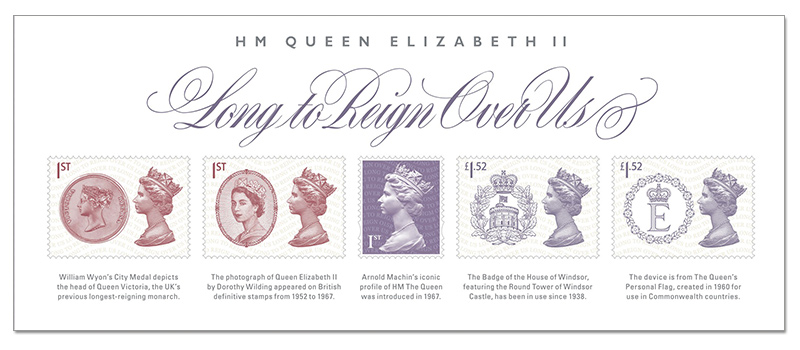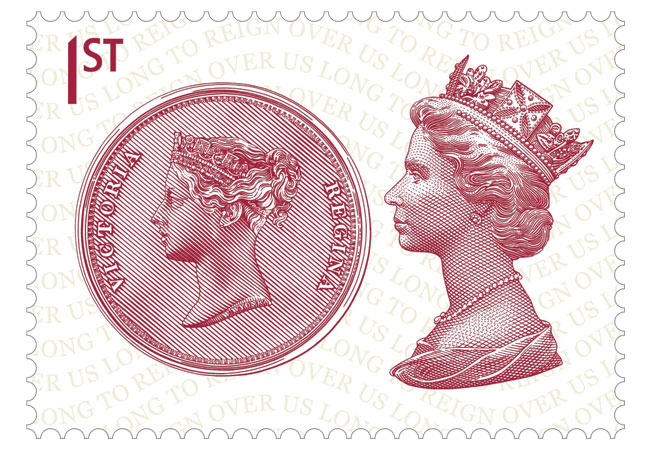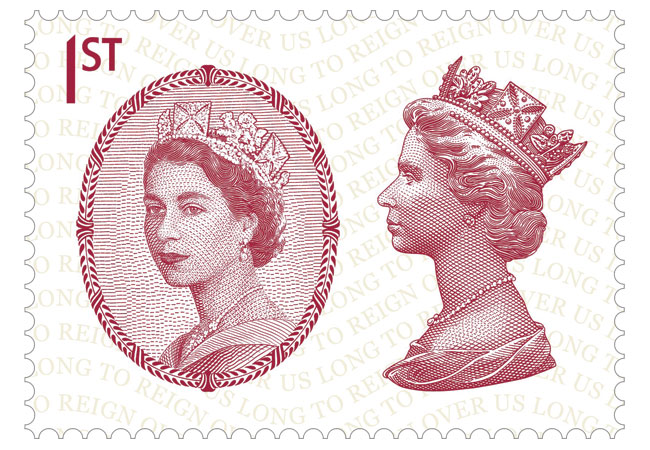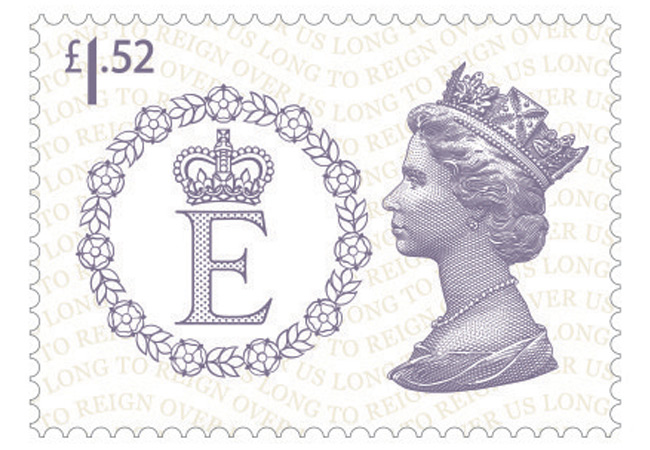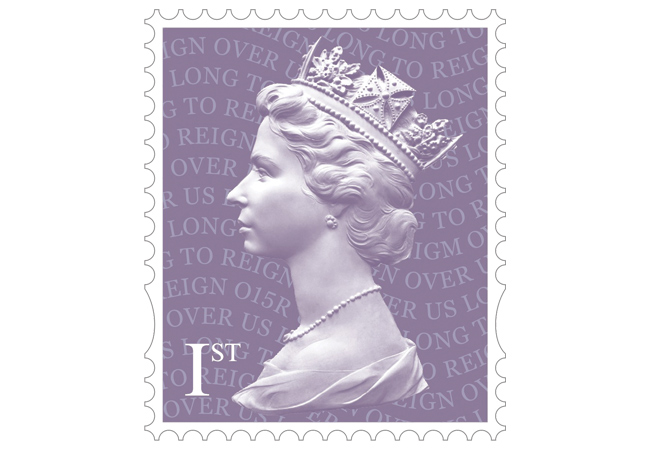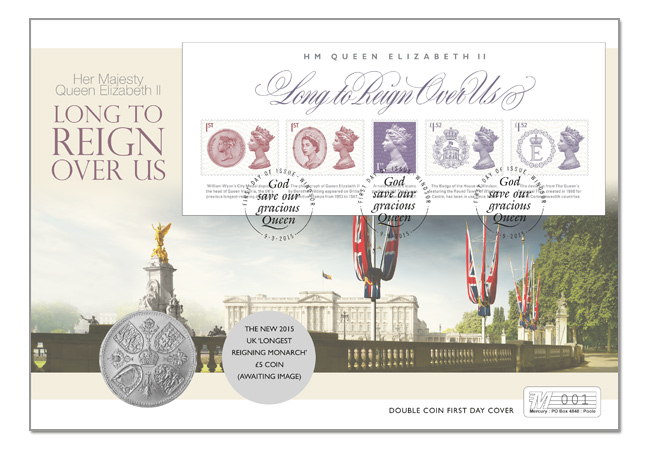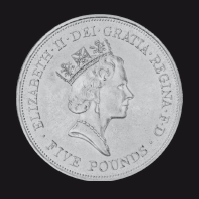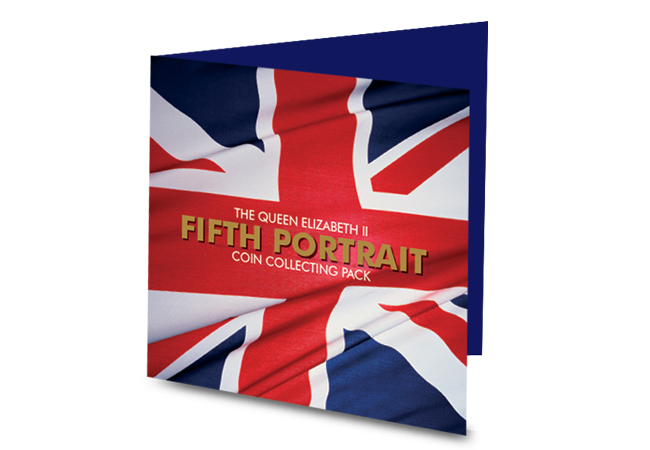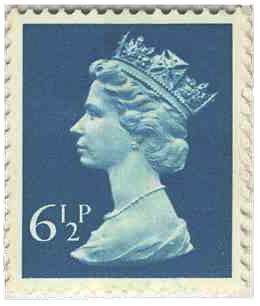Posts Tagged ‘Arnold Machin’
First Look: The UK’s New Longest Reigning Monarch Stamps
Royal Mail has issued a set of five new stamps marking Her Majesty Queen Elizabeth II becoming our Longest Reigning Monarch.
Each stamp features a different regal design highlighting a key Royal motif, and there is a new 1st Class definitive for use on everyday letters too.
I’ve managed to get hold of some of the stamps fresh off the press so I can show them to you here on the blog…
1st Class
In a nod to the historical precedent for the occasion this stamp features William Wyon’s ‘City Medal’. Depicting the head of Queen Victoria – the UK’s previous longest reigning monarch – the medal was struck to commemorate her first visit to London. The image on the Penny Black was based on this portrait, which in turn was based on a sketch of Princess Victoria when she was 15 years old.
1st Class
Dorothy Wilding’s three-quarter profile photograph of Queen Elizabeth II was one of a series taken in April 1952 and appeared on British postage stamps from 1952 until 1967.
It is reprised here, an unprecedented pairing of the two most important images of the Queen in British postal history.
£1.52
The House of Windsor came into being in 1917, when ‘Windsor’ was adopted as the British Royal Family’s official name by a proclamation of King George V, replacing the historic name of Saxe-Coburg-Gotha. The Badge of the House of Windsor shown on this stamp – featuring the Round Tower of Windsor – has been in use since 1938.
£1.52
The second high-value stamp bears the Personal Flag of Queen Elizabeth II. This is a standard that can be used on any building, ship, car or aircraft in which the Queen is staying or travelling. It is often used to represent her role as Head of the Commonwealth.
1st Class Definitive
In 1966 the HM The Queen approved Arnold Machin’s design for an effigy of her to be used on what came to be known as the “Machin series” of British definitive postage stamps. This latest edition is printed in a new mauve colour and the text in iridescent ink repeats the phrase, ‘Long to Reign Over Us.’
There is also a new commemorative postmark featuring the opening lines from the national anthem – ‘God Save Our Gracious Queen’ – which complements the stamps superbly. Any commemoratives using this postmark are sure to be sought after in the future – it is a true one-of-a-kind.
Suffice to say, these five new stamps are an intelligent, subtle and dignified tribute to Her Majesty Queen Elizabeth II’s remarkable reign. As it is extremely unlikely her record will be broken in our lifetime, these could well become some of the most sought after QEII stamps ever issued.
You can own all five of these stamps now, postmarked with the first day of issue date 9/9/2015, and affixed to a commemorative Double Coin Cover. Featuring the new UK £5 Coin, you can read more about it by clicking here…
Portraits of a Queen – which is Britain’s favourite?
With the new portrait of Queen Elizabeth II due to be revealed on Monday, I thought I’d revisit a blog I posted in 2013, which saw the 60th anniversary of the Queen on our coinage.
Back then you voted Mary Gillick’s 1953 portrait of the Queen the best, by a very slim margin. Will the new portrait become the nation’s favourite? Let’s take a look at the previous designs…
The first Queen Elizabeth II coins were struck in 1953 and since then four different effigies adorned our coins.
1953 – 1967: Mary Gillick
The first coins of Queen Elizabeth’s reign bore Mary Gillick’s portrait of the young Queen, engraved especially for the new coins.
Her uncrowned portrait of the Queen is still used on the Maundy Money distributed each year by Her Majesty.
With the upcoming decimilisation, it was decided to refresh the Queen’s portrait with Arnold Machin’s new sculpture of the Queen. Commissioned in 1964, it first appeared in 1968 on the new 5p and 10p coins. A version of the design with tiara was also introduced on stamps in 1967 and remains to this day.
1985 – 1997: Raphael Maklouf
In creating his new effigy of Her Majesty, Raphael Maklouf aimed “to create a symbol, regal and ageless”.
His “couped” portrait depicts Queen Elizabeth II wearing the royal diadem favoured by her on the way to and from the State Opening of Parliament.

The current Queen’s head on our coinage was designed in 1997 by Ian Rank-Broadley. Created to fill the full circle of the coin, its larger size was a deliberate response to the smaller 5p and 10p coins in circulation. A noticeably more mature portrayal of Her Majesty, Rank-Broadley aimed to show the Queen with “poise and bearing”.
If you’re interested…
Collect all 8 of the ‘new portrait’ coins when you find them in your change with The Queen’s New Portrait Coin Collecting Pack. Available now for just £3.99 (+p&p).
The 50th anniversary of the most reproduced image in the world
50 years ago in 1964 Her Majesty the Queen approved a new portrait for her coinage, and set in motion a chain of events that led to the creation of the most reproduced image in the world.
The portrait in question was designed by Arnold Machin RA – and if you look in your pocket now you’re still likely to find a coin bearing the distinctive profile.
But even though millions of coins are struck every year – it was when the design was adapted for use on our stamps that it really took off…
300 billion and counting
Best estimates suggest that the Arnold Machin RA effigy of Queen Elizabeth II has now been reproduced on our stamps over 300 billion times – a staggering number.
In fact, amongst collectors, UK definitive stamps are now simply referred to as ‘Machins’ because the image is so ubiquitous.
But who is Arnold Machin RA, and how did he come to design this instantly recognisable image?
From pottery to sculpting the Queen’s portrait
Arnold Machin was born in 1911 in Stoke-on-Trent. Modelling and sculpture was in the family, but his father struggled to make ends meet with his freelance modelling job. Consequently Machin started work aged 14 at the Minton China Factory, as an apprentice china painter.
But he could not keep away from sculpture, and after a working for many years in the arts was appointed an associate member of the Royal Academy of Arts in London in 1947.
As if this wasn’t enough of an honour, in 1964 Machin was approached to design an effigy of the Queen for the new decimal coinage to be introduced in 1971. So, despite never having designed a coin before, Machin was granted four sittings with the Queen.
Cleverly using the bas-relief technique, which creates a raised sculpture from a plaster base, Machin came up with a design the Queen appreciated so much she has insisted it be used unchanged on our stamps for the past 40 years.
An £18,000 plaster cast
Perhaps testament to the enduring popularity of the image, and the design process behind it, one of Machin’s original plaster casts recently sold at auction for the princely sum of £18,000.
And I don’t think this will be the last we’ll hear of record breaking Machin sales – as time goes by the power of the image will not diminish, yet the availability of collectables will.
And now we are due to see a new portrait of the Queen on our coinage in 2015, this is bound to be an area to watch.
You may be interested in…

The Arnold Machin Queen Elizabeth II Philatelic Silver Set
The Westminster Collection is proud to present the first ever officially licensed silver philatelic set featuring Arnold Machin’s famous effigy of the Queen.
NOW SOLD OUT

